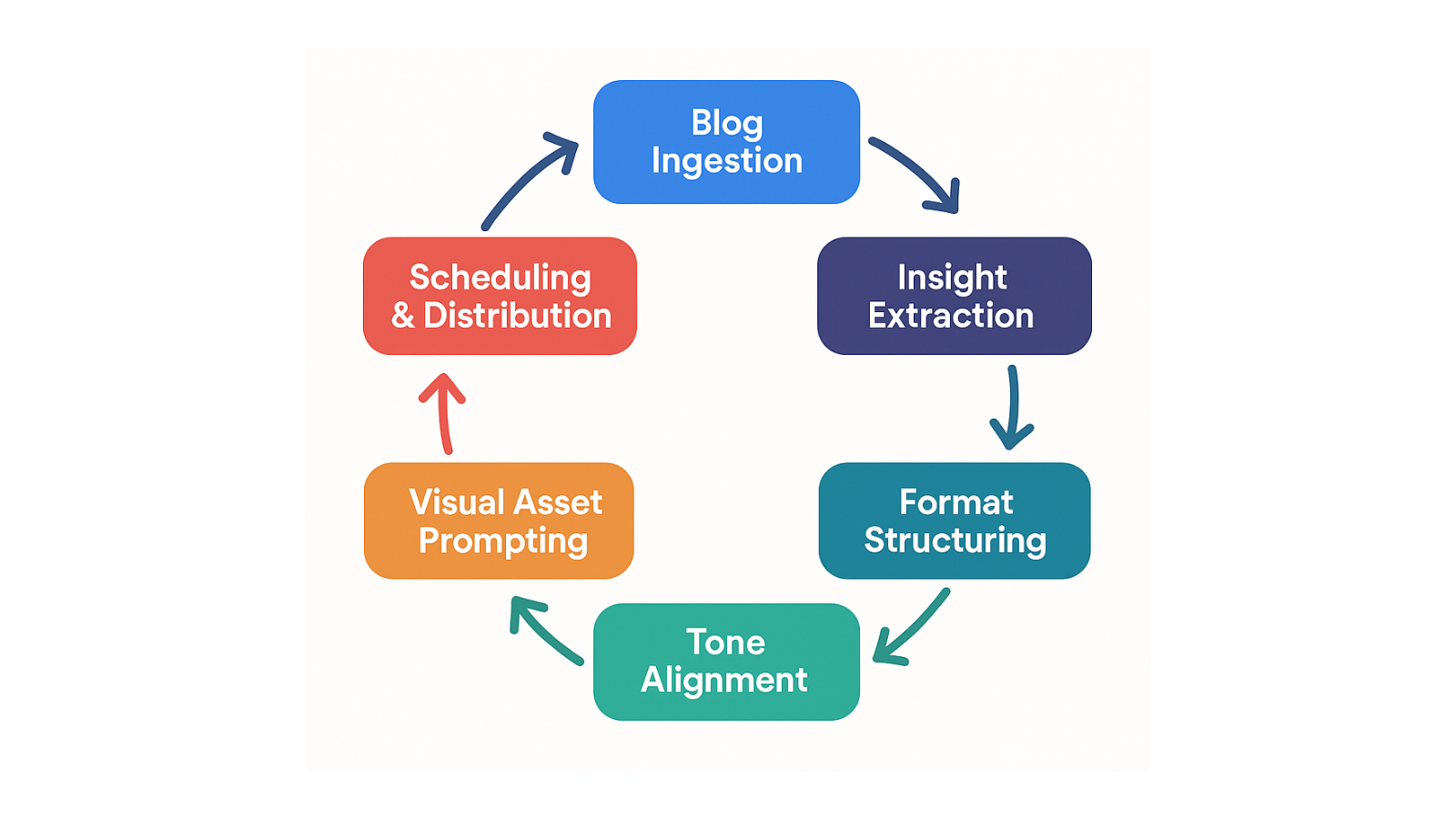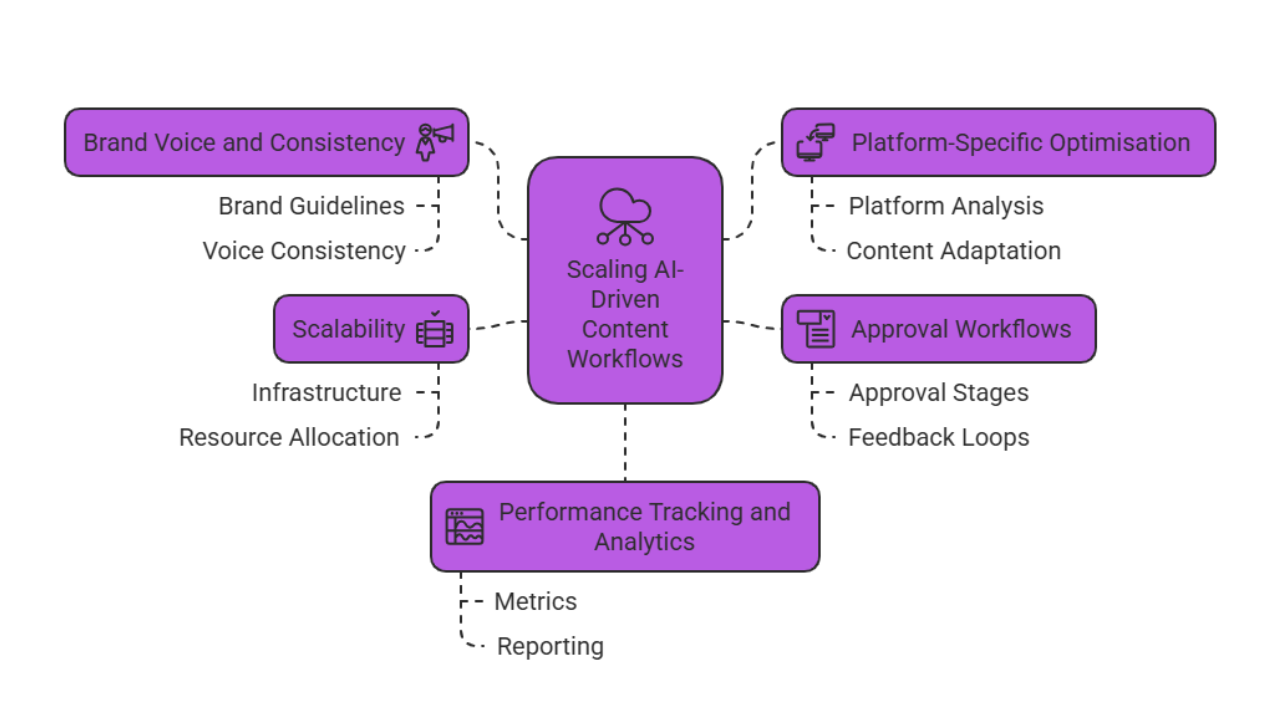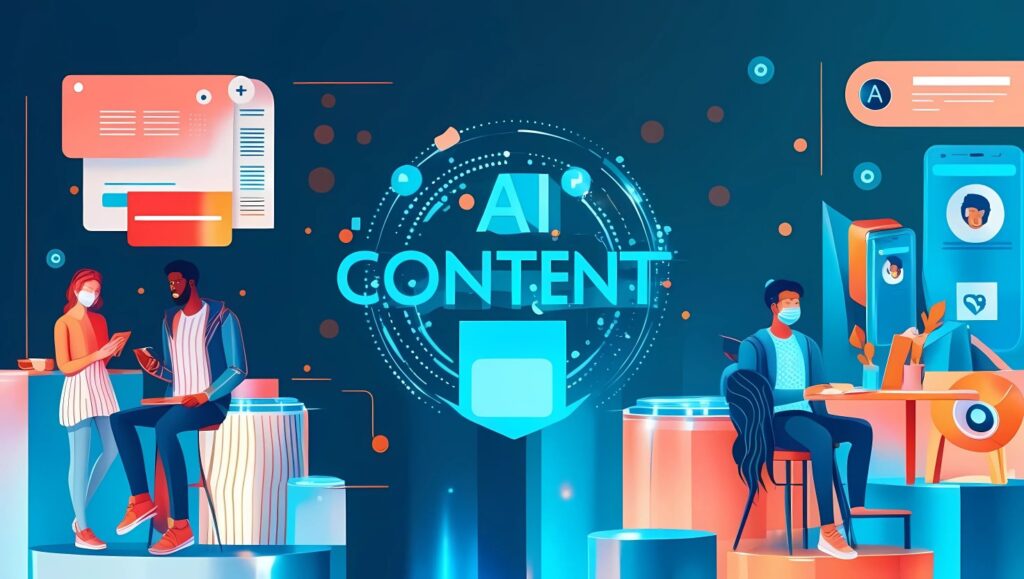Every week, businesses pour effort into creating high-quality blogs, but most of that content dies on the page. Why? Because distribution is manual, time-consuming, and often forgotten after the blog goes live.
With AI, this process changes completely.
Modern content teams are turning a single blog post into dozens of high-performing social media assets automatically. Whether it’s LinkedIn threads, Instagram captions, or tweet-sized quotes, AI tools now make it possible to repurpose, personalise, and publish at scale.
This blog explores how AI streamlines blog-to-social workflows and transforms your content into an engine for visibility and ROI.
The Distribution Gap: High-Value Content, Limited Reach
Despite investing considerable effort in producing high-quality blogs, many organisations struggle to ensure their content reaches the intended audience. The core issue? Distribution is often inconsistent, manual, and deprioritised once the content is published.
This leads to a common phenomenon: excellent content underperforming due to a lack of structured repurposing workflows. Valuable insights remain locked within long-form formats, rarely reused across high-traffic channels like LinkedIn, Twitter, or Instagram.
AI offers a compelling alternative.
Rather than relying on resource-heavy manual workflows, AI-driven content engines can identify, extract, and repackage key insights into platform-specific formats within minutes.
Manual vs AI-Powered Content Repurposing
| Attribute | Manual Process | AI-Enabled Workflow |
| Time per asset | 20–30 minutes | Under 3 minutes |
| Output per blog | 2–4 micro-assets | 10–15 assets |
| Brand tone consistency | Writer-dependent | Prompt-engineered templates |
| Turnaround time | Days to weeks | Real-time |
| Personalisation | Limited | Persona and channel-specific |
| Scalability | Restricted by team bandwidth | Scales with minimal oversight |
The shift from manual to AI-powered distribution enables marketing teams to move beyond static publishing. A single blog post can now serve as a multi-format asset engine, maximising reach, improving time-to-market, and reducing distribution costs.
In short, the question is no longer “Can we repurpose this?” but “Why aren’t we doing it at scale?”
The AI-Powered Content Repurposing Framework
AI’s role in content marketing is rapidly evolving. It no longer stops at creation. Increasingly, its value lies in the ability to operationalise content at scale, turning a single long-form blog into an intelligent, multichannel distribution engine.
The framework below outlines the stages through which AI transforms blog content into platform-ready micro-assets, enabling consistency, agility, and extended reach.
Framework Breakdown

1. Blog Ingestion
The AI begins by parsing the blog’s structure, headings, subheadings, key points, CTAs, and metadata. This stage ensures that the model understands context, audience, and intent.
2. Insight Extraction
Using summarisation models and natural language processing (NLP), the AI identifies:
- Key insights
- Supporting statistics
- Quotable takeaways
- Calls to action: This enables the creation of value-driven social posts instead of generic summaries.
3. Format Structuring
Each platform requires a different narrative flow. AI dynamically adjusts structure to suit:
- LinkedIn: Hook → Insight → CTA
- Twitter: Thread or one-liner quote with hashtags
- Instagram: Caption-ready highlights with emoji or carousel cues
- YouTube Shorts or Reels: Script snippets or bullet points for video overlays
4. Tone Alignment
Maintaining brand voice is critical. Through prompt engineering and style training, AI ensures that all generated assets reflect a consistent tone, whether professional, consultative, or conversational.
This can be further fine-tuned by referencing high-performing posts from the brand’s archive.
5. Visual Asset Prompting
AI tools can generate prompts or content outlines for:
- Carousel slides
- Quote cards
- Short-form video scripts: Design-ready outputs can be handed off to design teams or integrated with generative design platforms (e.g., Canva, Midjourney).
6. Scheduling & Distribution
Once assets are created, AI can auto-schedule posts based on performance data:
- Best posting times per channel
- Optimal asset mix per week
- Performance tracking loop (reach, engagement, CTR)
This final stage closes the loop by ensuring content doesn’t just exist, it performs.
By automating the content repurposing pipeline, AI enables marketing teams to shift from a “create-publish-forget” cycle to a continuous distribution engine, one that’s faster, more consistent, and inherently scalable.
Real-World ROI: Output, Cost, and Reach
AI-enabled content distribution is not merely about automation—it’s about maximising efficiency, consistency, and return on investment. When businesses implement an AI-driven repurposing workflow, they unlock significant value across multiple performance metrics.
The impact can be measured across three key areas:
- Output: Increased content volume without increasing headcount
- Cost: Lower production and distribution costs per asset
- Reach: Higher visibility driven by frequency, timing, and platform-optimised content
Traditional vs. AI-Enabled Content Distribution
| Metric | Manual Workflow | AI-Driven Workflow |
| Assets per blog | 3–5 | 10–15 |
| Time per campaign | 5–7 hours | Under 1 hour |
| Roles required | Writer, designer, scheduler | One AI operator or editor |
| Cost per campaign (est.) | $250–$500 | <$50 |
| Campaign turnaround | 3–5 days | Same day |
| Typical social reach | 2,500–5,000 views | 10,000+ views (multi-post) |
| Message consistency | Medium (manual variation) | High (style-aligned outputs) |
| Persona targeting | Rarely customised | Easily segmented |
Strategic Advantages
- Faster go-to-market: Blog content can be turned into social assets on the same day of publishing.
- Platform diversity: Tailored outputs mean no need to compromise between formats, threads for Twitter, carousels for LinkedIn, video scripts for Reels, and more.
- Compounding visibility: More frequent and targeted distribution increases the lifespan and discoverability of evergreen content.
By significantly reducing content fatigue and repurposing delays, AI empowers small teams to perform like agencies, delivering volume at velocity, without sacrificing brand alignment.
Cross-Functional Use Cases: Amplifying Impact Beyond Marketing

AI-powered content repurposing isn’t just a marketing efficiency play, it’s a cross-functional growth enabler. By turning a single blog into diverse digital assets, multiple teams across the organisation can extract value tailored to their objectives.
Here are practical applications across key functions:
Marketing & Growth
- Campaign Acceleration: Blogs become the seed for 10+ social assets, reducing time-to-publish for campaigns.
- Channel Optimisation: Each platform receives content aligned with its format, e.g., Twitter threads, LinkedIn carousels, Instagram captions.
- Evergreen Strategy: AI resurrects older high-performing blogs by turning them into fresh social narratives.
Sales Enablement
- Micro-narratives for Outreach: Convert blogs into LinkedIn posts, conversation starters, or email snippets tailored for prospecting.
- Insight Snippets: AI extracts key product benefits or case studies to reinforce sales decks or demos.
- Persona-Based Content: Create variations of the same post for different audience segments (e.g., mid-market vs. enterprise buyers).
Leadership & Personal Branding
- Thought Leadership Amplification: Blogs authored by executives can be turned into short posts with direct attribution.
- Consistency Without Time Investment: AI drafts can maintain regular presence on social platforms, aligned with tone and priorities.
Recruitment & Employer Branding
- Culture Blog Repurposing: Turn HR or culture-focused blogs into visual posts for careers pages or LinkedIn.
- Team Spotlights: AI extracts quotes, achievements, or behind-the-scenes content to showcase employee stories.
By integrating AI into their content workflows, organisations break down silos and democratise content impact, ensuring every team has a voice and a tool to amplify it.
Critical Considerations When Scaling AI-Driven Content Workflows
AI-powered content repurposing offers significant benefits, but scaling these workflows requires careful attention to several critical factors. To ensure long-term success and ROI, businesses must consider the following:

1. Brand Voice and Consistency
AI is only as good as the prompts it is given. Ensuring that the repurposed content stays aligned with your brand voice across different platforms is crucial. This means:
- Fine-tuning AI models: Train your system with high-quality examples from your content archive.
- Consistency checks: Regularly review generated posts for tone, messaging, and alignment with the brand’s identity.
While AI can automate the process, human oversight is essential to maintain authenticity.
2. Platform-Specific Optimisation
Each social media platform has its nuances—what works on Instagram won’t necessarily perform on LinkedIn. To maximise the impact of AI-powered repurposing:
- Platform-specific prompts: Create templates or guidelines for AI to ensure posts are optimised for platform algorithms (e.g., hashtags on Instagram, concise messages on Twitter).
- Frequency and scheduling: AI can analyse historical data to recommend the optimal frequency and time for posting, ensuring posts are not only relevant but timely.
3. Approval Workflows
Especially for regulated industries or high-stakes content, having a defined approval process is crucial to prevent errors or compliance issues. Consider:
- Content flagging: Set up AI to flag certain types of content (e.g., sensitive or legal issues) for manual review.
- Automated feedback loops: Implement systems where human feedback can continuously improve AI-generated content.
4. Scalability
AI’s primary advantage is scalability. However, businesses need to ensure that their technical infrastructure can handle growing content volumes:
- Cloud-based solutions: Ensure your AI tools are integrated with scalable cloud systems to support high-volume content generation.
- Resource allocation: Balance AI-driven workflows with existing resources to avoid overloading teams or tools.
5. Performance Tracking and Analytics
While AI can produce content efficiently, businesses must track the performance of each post:
- Data-driven insights: Use AI’s analytical capabilities to gauge engagement, conversions, and overall content performance.
- A/B testing: Use automated A/B testing to refine and optimise posts in real-time, adjusting based on live data.
Conclusion: Turning AI Frameworks into Business Outcomes
AI-powered content repurposing is not just an automation tool; it’s a strategic shift that enables businesses to scale content distribution across multiple channels with speed, consistency, and efficiency. By integrating AI into your content workflows, you unlock the potential to amplify reach, improve engagement, and reduce costs, without compromising quality or brand voice.
The key to success lies in scaling AI responsibly, maintaining oversight, and continuously optimising processes. With the right framework, your content doesn’t just get repurposed, it becomes a driving force for business growth.
Ready to elevate your content strategy with AI? Streamline, scale, and succeed. Get in touch with us.


